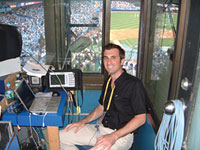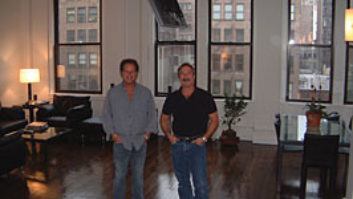
Composer Brian Langsbard surveys the All-Star Game opening ceremonies at
Yankee Stadium.
Photo: David Weiss
The World Series is upon us once again, but this month’s “Metro” turns our focus back a few months to another huge baseball event: The 79th Major League All-Star Baseball Game held in July was the longest All-Star contest in history. But for at least one interested observer — composer Brian Langsbard up in Yankee Stadium’s ancient audio booth — it was a 15-minute portion of the pre-game ceremony that felt like an eternity.
Stakes were extra high on that July 15th, because as 2008 is the final year of operation for the Yankees’ historic home park (in business since 1923), the game was the final All-Star event ever to be held there. Months before the contest, the L.A.-based Langsbard was informed by Major League Baseball (MLB) that his services would be needed in the Bronx, not simply to compose 25 minutes’ worth of original anthemic music, but also to trigger the pieces live during the ceremonies. As an experienced TV composer (Snapped, City Confidential), MIDI preview orchestrator for film (Air Force One) and videogame composer (Buzz Aldrin’s Race Into Space, The Simpsons: Virtual Springfield), as well as a veteran of previous MLB on-field presentations, Langsbard was ideal for executing the dual assignment.
“Baseball is the only sport with a true musical tradition — where everyone stands up and can sing the same song [“Take Me Out to the Ballgame”] together,” Langsbard points out. “The MLB producers have the best ears of anyone I’ve worked with. They’re quite demanding because they’re used to licensing live orchestral music. So I have to convince them that I’ve used a live orchestra or it doesn’t get approved.”
A self-confessed film-score fanatic since high school, Langsbard was unknowingly preparing for the MLB gig by pushing the composing and recording envelope every chance he got. His big break came working with Joel McNeely on the 1997 blockbuster film Air Force One. “Joel wrote a third of the music of that movie for Jerry Goldsmith,” Langsbard says. “It was my job to produce orchestral mockups of Joel’s music for the director, Wolfgang Petersen. Joel held me to extremely high standards of making that music sound as realistic as possible since that would have a big impact on how the director felt about the score. Then, being able to hear the real orchestra version of Joel’s music later allowed me to A/B my mockups with the real thing.”
Langsbard got an order for six different pieces of music for the 79th All-Star Game, including an intro, themes for the roll call of the National League and American League starters and non-starters, and one for the first pitch. Of particular interest, however, were the pieces that accompanied the entrance and roll call of 49 of the 64 living Hall of Fame Baseball players — an event of unpredictable length that would test Langsbard’s nerves and experience for proper playback on the day of the big game.
Working out of his digital/analog hybrid personal studio in Mar Vista, Calif., Langsbard set to work using his Mac Pro Core 8 running a Logic 8 front end for Pro Tools HD. The computer side is complemented by outboard gear that includes a Manley SLAM!, Avalon 747, Empirical Labs FATSO and Apogee PSX-100 converters. Of supreme importance to Langsbard are the East West Symphonic Orchestra and Vienna Symphonic Library, taking up multiple gigs of memory on his hard drive. “I should give credit to those sample libraries,” Langsbard says. “I would never choose one or the other when I could have both.”
Langsbard set out to reflect the MLB sound. “We always toss around words like cinematic, heroic, orchestral, patriotic, moving and a certain degree of Americana,” he says. “For the Hall of Fame piece, MLB wanted the energy sustained for a full 15 minutes. Compositionally, I used every trick in the book: new transitions, varying themes, keeping a driving percussion track running — which helps give it a constant feeling of movement and progression, and always save the choir for the big finish!”
With his history scoring for the big screen and past MLB events — including on-field presentations for the 2005 World Series and 2007 All-Star Game — Langsbard’s experience in combining live events and cinematic composing sensibilities would pay off for the New York City show. “After doing two gigs previously, I know what to expect and how it’s going to feel in the stadium,” notes Langsbard. “This event is like a montage of scenes on the field that unfold, all scored to music meant for a crowd, where it’s simply doing the job of supporting an emotion.”
At Yankee Stadium on game day, MLB wisely decided that only Langsbard should be trusted with triggering the music cues during the ceremonies. Squeezed into the smallest major-league audio booth imaginable, when game time arrived he triggered his cues off a trusty and fortuitously tiny Mac G4 laptop from the live-mixing program DJ.
“I cannot quite explain just what a rush it is to hear my music blast through the sound system at Yankee Stadium,” Langsbard says. “Without a doubt, the regal and historic nature of this event far surpassed any other job I’ve been a part of, and I was very proud to be part of such a tight production team. I may have aged at a slightly quicker rate during that whole week — I wouldn’t trade it though!”
Send New York news to
[email protected].

